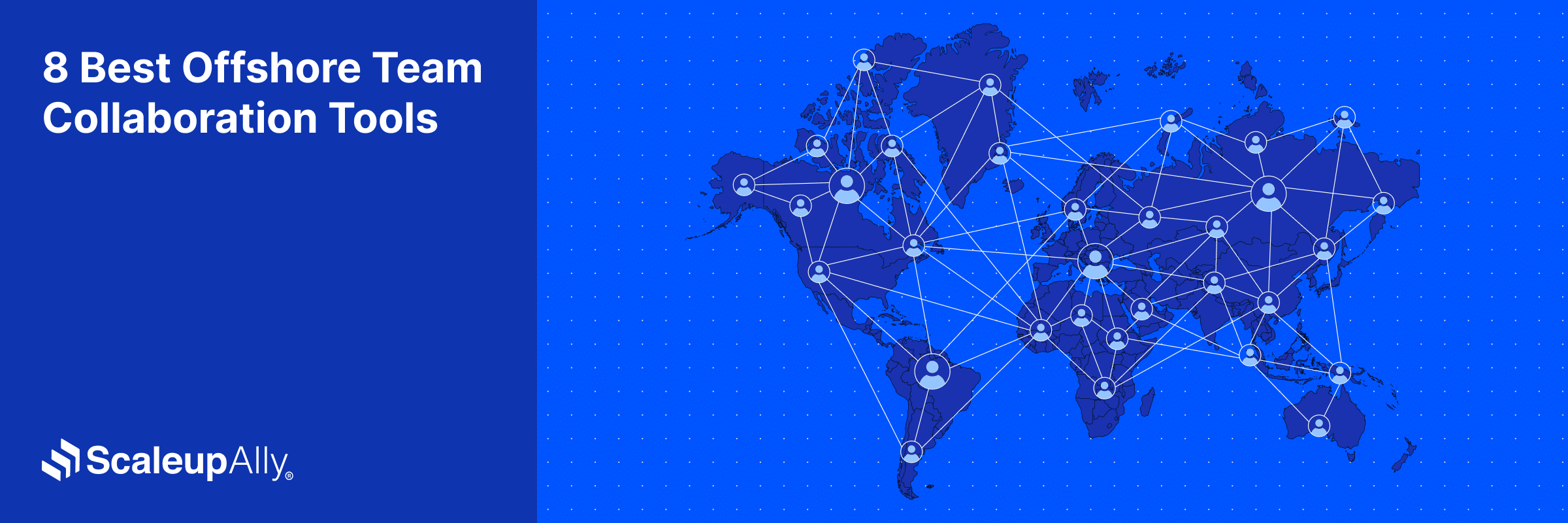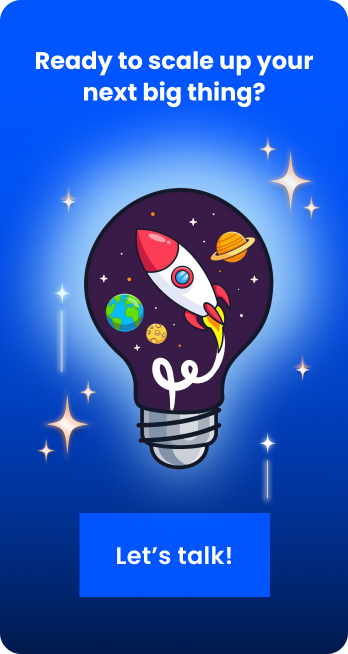
Offshore Team Collaboration Tools: 8 Picks That Keep Teams in Sync
Pranay Agrawal | October 29, 2025 , 10 min read
Table Of Content
A developer in Bangalore merges code, a designer in Warsaw polishes the visuals, and you ship the release from San Francisco—no late-night scramble required.
That round-the-clock cadence rests on a single pillar: offshore team collaboration tools built for async work and time-zone gaps. In this guide, we unpack 8 standout platforms, a quick comparison matrix, and the culture-fit check most lists skip. Before diving in, skim our guide on how to work with offshore teams for the ground rules.
Key Takeaways
- Lead with async, escalate to sync. Default to threads, comments, and scheduled send; use quick huddles or calls only when discussion stalls.
- Choose for ecosystem fit, not feature FOMO. Tools that auto-hand off context (chat → task, calendar → call link, doc → recap) beat siloed “best” apps.
- Make culture your operating system. Run a quick team-style assessment, publish response-time SLAs, and standardize hand-off rituals before tool sprawl sets in.
- Design for real-world constraints. Prioritize lightweight UIs, mobile parity, offline modes, and clear permissions/audit trails for cross-border work.
- Turn time zones into a conveyor belt. Chain tasks by dependency, record/summarize the few meetings that matter, and centralize decisions in a living wiki to keep progress moving 24/7.
Choosing Tools That Bridge Distance
Let’s establish a clear evaluation framework before ranking apps; otherwise, you risk optimizing for features rather than eliminating offshore hand-off friction.
- Async vs. sync balance. Favor tools that default to threads, annotated documents, and scheduled send, with one-click escalation to live discussion when needed. Survey roundups report that about 75% of remote workers prefer asynchronous communication, reinforcing an async-first posture.
- Integrations and ecosystem fit. Reduce context switching by selecting platforms where a message can become a task and calendar invites automatically include join details—for example, Asana’s native Slack actions and the Microsoft Teams add-in that schedules meetings directly from Outlook.
- Security and admin controls. Cross-border collaboration heightens compliance requirements. Prioritize single sign-on, role-based access, unified audit logs, and retention controls (e.g., Microsoft Purview Audit; Google Workspace SAML and audit logging).
- Adoption and bandwidth reality. Teams operate with uneven connectivity. Prefer lightweight interfaces with strong mobile parity and offline modes so work continues during outages (e.g., Google Docs/Sheets/Slides offline; Notion offline).
- Cultural fit and team norms. Tools are durable only when usage is standardized—define where updates live, expected response times, and hand-off rules so each region works to the same playbook.
Keep these five criteria visible as you evaluate the nine offshore collaboration tools that follow.
8 Best Offshore Team Collaboration Tools
1) TeamDynamics: culture-fit insights that make collaboration click
Most teams lack a precise view of how they collaborate. TeamDynamics addresses this with a brief, research-backed assessment that maps a team across four collaboration dimensions – communicating, processing, deciding, and executing – and assigns one of sixteen TeamDynamics types; each individual also receives a CoDynamics profile showing alignment with the team’s style.
The platform delivers an interactive, shareable report that surfaces behavioral patterns, decision habits, execution approaches, and areas of strength and friction, providing practical guidance for leadership, workflow design, and team conversations.
Pricing:
Free rapid result (trial);
Solo: $29 one-time;
Pro (2–20 users): $39 per user one-time;
Enterprise (>20 users) and Coaches/Consultants: contact for pricing.
TeamDynamics is a standalone, self-serve platform with no technical integrations by design, minimizing setup and administrative overhead.
2) Slack: real-time chat with async power
Slack’s value for distributed teams is the reduction of catch-up time. Channels organize work by topic, threads keep discussions contained, and scheduled send enables updates across time zones without off-hours notifications. When synchronous discussion is required, a huddle can be launched from any message with full context preserved.
In June 2025, Slack added conversation summaries and huddle notes to paid plans, providing rapid context for teammates who were offline. With knowledge workers losing significant time to context retrieval, concise recaps help distributed teams absorb long discussions in minutes.
Slack integrates effectively with adjacent systems. For example, message actions can create tasks in Asana, and meeting recordings can be routed to a #daily-recap channel. Teams gain responsiveness without relying on constant online presence.
3) Microsoft Teams: chat, meetings, and files under one roof
For organizations standardized on Microsoft 365, Teams provides a unified workspace. Chat, SharePoint files, and Outlook calendars are co-located, and meetings can be initiated directly from the interface. After meetings, Copilot’s Intelligent Recap posts recordings, AI-generated notes, and follow-ups to the relevant channel, allowing global colleagues to review outcomes quickly.
Adoption and scale are well established—Team usage among large enterprises is extensive—indicating stability for long-term offshore collaboration. Security and administration are centralized: multi factor authentication, retention, and auditing are managed in the 365 console, reducing operational overhead for engineering teams.
4) Zoom: video calls that shrink continents
While asynchronous work should be the default, certain decisions benefit from live discussion. Zoom provides reliable connectivity across varied networks and environments. High-quality audio improves clarity in noisy settings, and breakout rooms support structured workshops for larger groups.
AI Companion generates transcripts and action-item summaries, distributing outcomes to attendees and stakeholders who were offline. With expanding language support and automatic detection, mixed-language teams receive consistent recaps. The result is a repeatable process: record, summarize, and convert discussion into actionable artifacts.
5) Asana: project management that nails the hand-off
A task in Asana is more than a to-do; it’s a mini contract. Every card has one owner, one due date, and subtasks that uncover hidden work. When your Los Angeles PM drags a story to Ready for Review, Asana pings the tester in Kuala Lumpur and keeps the relay moving without a status meeting.
Dependencies and Timeline views—features that often earn Asana top marks among team-performance software platforms—show what blocks what, turning overnight surprises into planned hand-offs. That clarity matters: teams that visualize dependencies in Asana resolve blockers 26 percent faster on average, according to the platform’s 2024 customer-impact study.
Recent AI enhancements like Smart Summaries and AI Teammates condense long threads and propose next steps, helping teams process feedback that accumulates across time zones. Integrations with Slack and Teams ensure updates surface where people already work, while the Work Graph provides a consistent source of truth.
6) Google Workspace: live co-editing for nonstop progress
Docs, Sheets, and Slides support real-time and asynchronous editing with robust version history and Suggest mode for structured review. Resolved comments provide an audit trail for decisions, enabling teams to follow the evolution of a document across regions.
Smart canvas elements and Gemini for Workspace add summarization, drafting, and translation capabilities, accelerating review cycles. Calendar and Meet integrations minimize friction: calls launch from the document context, recordings can be referenced later, and collaborators can resume work without searching for links.
7) Notion: your always-on knowledge hub
Notion functions as a centralized knowledge base where pages combine narrative, databases, and lightweight project tracking. Wikis, SOPs, and project hubs live in one place, reducing fragmentation across tools and inboxes.
Because every page is a database, changes propagate across linked views, keeping status and ownership consistent. Notion AI condenses notes into action lists and summaries, and newer capabilities such as Mail unify decisions captured in email with the workspace. Permission controls allow precise sharing—external partners can comment while core teams retain edit access—so the knowledge base scales with the organization.
8) Miro: a visual playground for async brainstorming
Miro provides an infinite canvas for mapping journeys, systems, and ideas. Teams add templates, stickies, and diagrams, then annotate and reorganize asynchronously. Activity trails and comments preserve rationale for those reviewing later.
Miro AI clusters inputs and produces board summaries, allowing contributors who missed workshops to arrive at the key insights quickly. Embedding boards in Slack, Confluence, or Notion connects discovery to specification without screenshots. Enterprise controls such as SSO and data-residency options support compliance requirements while enabling open collaboration.
Comparison Snapshot: Picking the Right Tool at a Glance
| Tool | Primary role | Offshore superpower | Watch-out |
|---|---|---|---|
| TeamDynamics | Team assessment | Codifies async vs. sync rules and feedback styles | Only valuable if teams apply the insights in rituals |
| Slack | Team chat | Threads, scheduled send, AI summaries for quick catch-up | Feels always-on without clear channel norms |
| Microsoft Teams | Suite hub | Chat, meetings, and files in one M365 wrapper | Can be heavy for teams with about 25 seats or fewer that don’t use Microsoft 365 |
| Zoom | Video meetings | Reliable calls plus AI summaries for absentees | Meeting fatigue if every decision needs a call |
| Asana | Project management | Clear dependencies and timeline hand-offs | Requires discipline to keep tasks current |
| Google Workspace | Docs suite | Live co-editing and comment threads that work offline | Suite lock-in; mixing vendors gets messy |
| Notion | Wiki + light PM | Databases and linked views build a living handbook | Needs structure guidelines to avoid sprawl |
| Miro | Visual whiteboard | Async brainstorming on an infinite canvas | Boards can clutter if templates pile up unchecked |
Implementation Playbook: Turn Time Zones into an Advantage
Time differences may look like a constraint on paper. In practice, they can add up to 16–24 hours of daily progress when you follow the steps below, exactly what follow-the-sun workflows promise to deliver (Wikipedia).
- Codify the rules first. Run a TeamDynamics assessment and publish a one-page agreement that separates async (threaded chat, doc comments) from sync (live calls). Include response-time targets and emoji definitions so no one debates whether a 👍 means “approved” or “circle back.”
- Build a follow-the-sun chain. In Asana, set task dependencies so each item unblocks the next region in line for your remote development team, and post a #handoff message in Slack with a Loom video and checklist; a Kuala Lumpur tester can pick it up during their morning stand-up without a status meeting.
- Record essential meetings. Zoom or Teams calls should autopost AI summaries to the project channel. TechSmith’s 2024 study found that teams using async video updates cut live meetings by 28 percent year over year (Noota).
- Centralize the knowledge. Store decisions and design rationales in Notion or Google Docs, then link them from a wiki. New hires find the backstory with one search instead of scrolling chat history.
- Lock down access before you scale. Turn on single sign-on, role-based permissions, and retention rules across the stack so compliance stays calm while product teams stay fast.
Conclusion
Follow this loop and the clock stops being a blocker; it becomes a conveyor belt that moves work forward while you sleep. When these eight tools are wired into the five ground rules—clearly separating async from sync, chaining tasks by dependency, recording the few meetings that matter, storing every decision in a shared knowledge base, and enforcing security upfront—time zones stop being a hurdle and become a power source, turning your workday into a seamless 24-hour relay where each region wakes up to fresh progress instead of buried blockers.
Frequently Asked Questions
Q: What is the average cost to develop a fitness app?
The average cost to develop a fitness app ranges from $25,000 to $300,000. The final cost depends on features, design, platform choice, and the development team’s location and experience.
Q: What features increase the cost of a fitness app?
Features like video streaming, real-time chat, wearable integration, custom workout plans, and AI coaching significantly increase development costs due to their complexity and the need for backend infrastructure.
Q: Is it cheaper to outsource fitness app development?
Yes, outsourcing can lower costs, especially if you hire skilled teams in regions with lower rates. It’s important to choose a reliable partner to ensure quality and timely delivery.
Q: How long does it take to build a fitness app?
It typically takes 3 to 9 months to build a fitness app. Simple apps may take less time, while complex ones with advanced features can take up to a year or more.
Q: What is the maintenance cost of a fitness app?
Maintenance usually costs 15–20% of the initial development cost per year. This includes bug fixes, updates, server costs, and support to keep the app running smoothly and securely.
Related Blogs

IT Outsourcing Costs Explained: Global Rates, Key Influencers & Cost-Saving Tips
Discover what IT outsourcing costs include, key pricing factors, hidden fees, regional rates, and how to pick a cost-effective outsourcing partner.
Pranay Agrawal
Nov 29 ,
13 min read

IT Consulting Rates Per Hour in 2025: Country & Industry Wise
Discover IT consulting rates broken down by experience, specialization, industry, and country. Plan your budget and find the right IT talent for your business needs.
Pranay Agrawal
Nov 25 ,
13 min read

Calculating ROI for Software Development: A Detailed Guide
Discover proven strategies and practical tips to enhance the ROI for software development projects. Learn how to measure success and increase profitability.
Manu Jain
Nov 25 ,
19 min read


